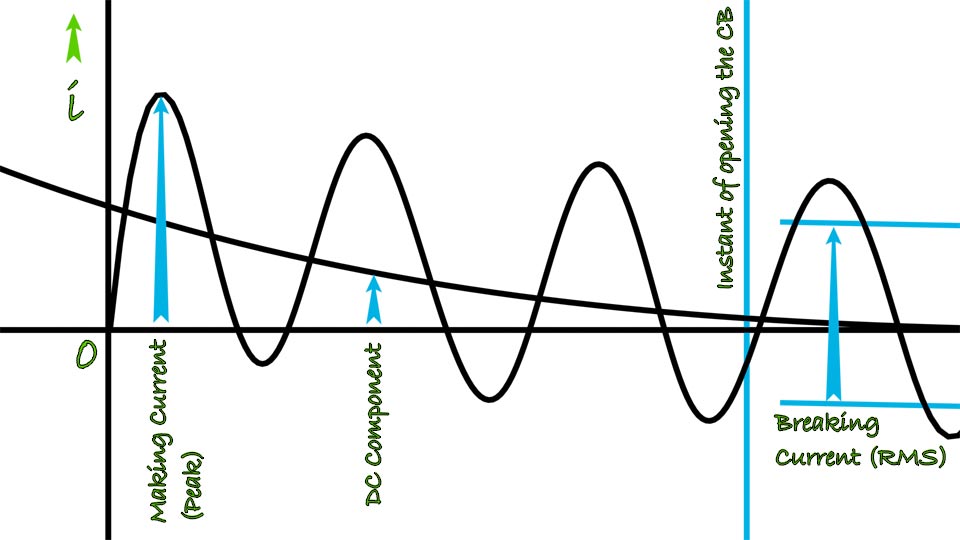Definition of Making Current
The rated short circuit making current of a circuit breaker is the maximum peak current that the circuit breaker can close without any damage. It is the maximum peak current that a circuit breaker can make safely.
Definition of Breaking Current
The rated short circuit breaking current, on the other hand, is the RMS current that a circuit breaker can break safely without any thermal or mechanical damage.
Behaviour of Short Circuit Current
Before understanding the entire concept, let us discuss the behavior of short-circuit current. Whenever a fault occurs, fault current starts flowing. Due to the presence of reactance in the circuit, the fault current will initiate with a DC offset. This means initially the fault current will have both AC and DC components. This is because the DC offset shifts the mean line of the wave from its zero axis.
So initially, the current has two components, one DC and one AC. Theoretically, due to the DC component, the total current initially will be two times that of the steady-state short circuit current. Due to the presence of reactance in the system, it is roughly 1.8 times the RMS value of the steady-state short circuit current.

Fault Scenarios for Circuit Breakers
Now, we will come to the making and breaking operation during a fault of a circuit breaker. There are two situations during a fault:
- The circuit breaker remains in the closed condition when the fault occurs in the system. The relay senses this fault, sends a signal to the trip circuit, and the breaker trips to isolate the fault.
- The circuit breaker has already opened and isolated the fault, but the short circuit persists in the isolated portion. If the breaker is closed again without rectifying the defect, the fault will reinitiate through the breaker.
Making Current During Breaker Closing
During the closing of the circuit breaker, the moving contact approaches the fixed contact. Due to the high voltage gradient, after a certain gap between the contacts, an arc initiates. This connects the faulty portion to the healthy system, and therefore, the circuit breaker itself creates the fault. As a result, fault current starts flowing.
The initial peak of the short circuit current is about 2.5 times the steady-state RMS short circuit current. This current passes through the breaker even before it has physically closed. The peak short circuit current through the arc creates a huge mechanical force that pushes back the closing contacts. The breaker must overcome this force to close safely with this peak current.
Why Making Current is in Peak Value
We refer to this first peak of the fault current as the making current of the circuit breaker. This means it is the maximum peak of the fault current the breaker can make without any mechanical damage. Since mechanical force is proportional to the square of the peak current, we express making current in peak value.
Due to the DC offset, the initial fault current is about twice the steady-state short circuit current. Expressing it in peak value requires multiplying by √2. Theoretically, it is 2 times the RMS steady-state value, but due to reactance, the AC component with DC offset is 1.8 times the steady-state RMS value. Therefore:
Rated Making Current = 1.8 × √2 × Rated Breaking Current = 2.5 × Rated Breaking Current
Breaking phenomenon: When a fault occurs, the breaker cannot open instantaneously because the relay must sense the fault and then send a command, and then the breaker opens. This delay allows the DC offset to decay, leaving only the AC component in the current waveform. Thus, when the breaker opens, only the steady-state fault current remains because the transient portion has vanished.
Breaking Current During Fault Clearing
A breaker cannot open in the first one or two cycles of a fault; it opens during steady-state short circuit current. Therefore, the rated breaking current is the maximum RMS current a breaker can interrupt without exceeding specified restriking voltage limits.
In other words, the rated breaking current is the short circuit current that the breaker can safely interrupt without thermal or mechanical damage due to arc restriking.
Thus, making current is expressed in peak value, and breaking current in RMS value. The rated making current is 2.5 times the rated breaking current. The breaker can make the initial peak fault current but cannot break it, and it only breaks steady-state short circuit current after the DC offset has decayed.
